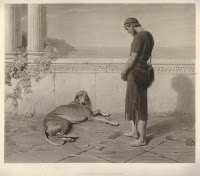An American XL bully and the Ancient Greek hell-hound Cerberus
as imagined by William Blake (c.1824-27)
I.
There are a lot of stories in the news at the moment about American XL bullies and, apparently, the breed will be banned in the UK as of the end of this year under the Dangerous Dogs Act (1991).
Clearly, that's a good thing, although, in my opinion, it doesn't go far enough and there should be no certificates of exemption issued to owners no matter how fit and proper they are deemed to be.
You can't have ultra-aggressive mutts with stocky, muscular bodies and powerful jaws running rampage on the streets and in the parks, causing serious injury to people and other canines. Six of the ten fatal dogs attacks in the UK last year were due to these illegally bred beasts.
However, if you think the XL bully living next door is a nightmare and genuine threat to the safety of your children, then probably best you don't read the next section of this post in which we discuss a three-headed hound of Hades ...
II.
According to ancient Greek mythology, guarding the gates of the Underworld is a monstrous, raw flesh-devouring dog named Cerberus, whom you really don't want to mess with (i.e., if you're dead, it's probably best to accept the fact and not attempt to leave).
Cerberus was the polycephalic offspring of Typhon and Echidna and described as having a serpent for a tail and snake-heads protruding from multiple parts of his body, ensuring that his bite was infinitely worse than his bark.
Thanks to his superhuman strength - and a wooden club - Heracles was just about the only one who could handle him, but, even then, I wouldn't have granted a dog license to this demi-god, nor allowed him to arrogantly parade Cerberus on a chain leash through the streets of Greece.
A ravenous animal like Cerberus belongs in Hades ensuring the dead don't come back to extract their revenge upon the living. Alternatively, let him guard over the gluttons who inhabit the Third Circle of Hell [1], giving them a few hard bites in order to encourage them to repent of their sins and eat less.
III.
Finally, just to end on a slightly happier, more dog-friendly note, let me remind readers of another mythological mutt from ancient Greece; one much-loved by Odysseus and called by the name Argos ...
According to Homer [2], after fighting in the Trojan War and battling monsters for twenty-odd years, Odysseus finally made it home to Ithaca. But as he approached his palace, he noticed an old dog lying on heaps of mule and cattle dung piled up outside the front gates. The poor creature was in a terribly neglected state, infested with fleas and other parasites.
Nevertheless, when Argos heard a familiar human voice, he raised his tired head and pricked up his ears. As soon as he was sure it was his master, he wagged his tail in excitement, but lacked the strength to get to his feet and greet Odysseus properly.
Seeing this - and touched by the fact that his dog clearly still remembered him after such a long time - Odysseus wiped away a tear, although, in his heart, he was angry that Argos had not been properly cared for in his absence and had fallen on hard times.
Tragically, having witnessed his master's homecoming, the loyal dog passed into the darkness of death - but what a good boy he was!
Print by Frederick Stacpoole after Briton Rivière (1885)
Notes
[1] The third circle of hell, as depicted in Dante's Inferno, is reserved for the punishent of those who have committed the sin of gluttony; a realm of freezing mud which, just to make matters worse, is also inhabited by the three-headed hound Cerberus, who torments the excessively greedy by tearing at their flesh.
[2] See Homer's Odyssey, Book 17, lines 290-327. My paraphrased account is based on various English translations and MLG's recollection of the tale, particularly with reference to Argos.
[3] Print by Frederick Stacpoole, after Briton Rivière (1885); held in the collection of the British Museum under the title Ulysses and Argus. Click here for more information.
For a follow-up post to this one on a related theme, please click here.


.jpg)
